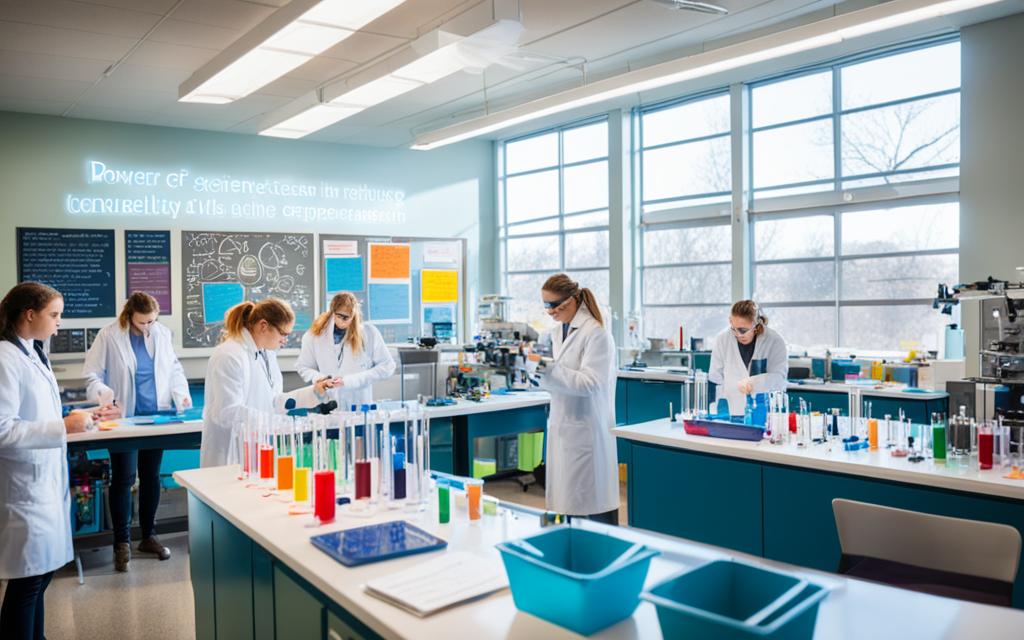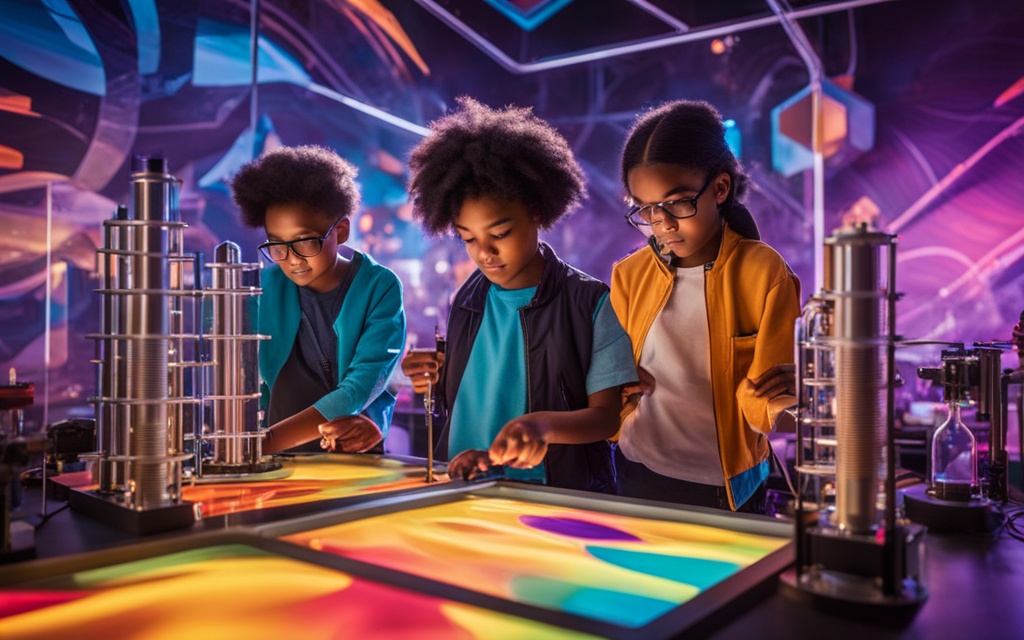Today, women scientists are leading vital research worldwide. Still, they only make up 33.3% of researchers overall. Their work often doesn’t get the recognition it should.1 Just under 4% of Nobel Prizes in science have been given to women. In Europe, only 11% of top research positions are filled by women.1 For over 20 years, the Fondation L’Oréal and UNESCO have been working to support women scientists. They aim to boost their scientific work and help them tackle the world’s pressing issues. Together, they have honored over 100 women with awards. Among them are five who have won Nobel Prizes.
Their efforts include the L’Oréal-UNESCO For Women in Science programs. These programs aid more than 250 young women researchers yearly. The support offered is critical during their graduate or post-graduate studies.
Key Takeaways
- Women scientists represent only 33.3% of researchers globally, and their work is often underrecognized.
- The Fondation L’Oréal and UNESCO have worked to empower women scientists, awarding over 100 laureates, including 5 Nobel Prize winners.
- The L’Oréal-UNESCO For Women in Science programmes support more than 250 talented young women researchers annually.
- Addressing the underrepresentation of women in science is crucial for driving scientific progress and innovation.
- Empowering future scientists through high-end programs can inspire the next generation of diverse scientific leaders.
Empowering Future Scientists
Starting kids early on scientific exploration is key to making future scientific leaders.2 The 5E Model guides young minds through hands-on and collaborative learning.2 This method, based on building knowledge from experiences, is more effective than traditional teaching.2
Providing Mentorship and Role Models in STEM Fields
It’s important for students to meet STEM mentors and role models.3 Many high school students are already doing serious science and getting published.3 Having mentors who share their writing and thinking processes helps a lot.3
Encouraging Hands-On Learning and Experimentation
Doing experiments and learning by doing is crucial for future scientists.2 The Year 9 Science Fair was a big success, with topics like water rockets and hydrogels.2 It let students show off their thinking and teamwork skills.2 This approach molds the makers and thinkers of the future.2
To empower the scientists of tomorrow, we need a mix of scientific curiosity, role models, and lots of hands-on learning.4 These approaches will bring out the best in young people and help them lead in science.
Breaking Barriers: The Role of Women in Science
Women scientists have made amazing breakthroughs. However, they still meet big challenges. Globally, women make up just 33.3% of the researchers. Their work doesn’t often get the recognition it should.1 Only a small number, less than 4%, of science Nobel Prizes have gone to women. In Europe, just 11% of the top research jobs are women.1
Celebrating the Achievements of Women Scientists
The Fondation L’Oréal and UNESCO support more women in science. They have helped over 100 women scientists and offered grants. Five of these women have since won Nobel Prizes.1 They also back over 250 young female researchers yearly. This help is crucial during their advanced studies.1
Inspiring the Next Generation of Female Researchers
Women in fields like engineering and computer science are not as many. But, in life sciences and health fields, they’re catching up. In areas like biology and medicine, we often see more women.1 Dr. Kizzmekia Corbett and Dr. Tu Youyou are great examples. Dr. Corbett helped make a COVID-19 vaccine. Dr. Youyou won a Nobel Prize for her work with artemisinin.1 They motivate other women to become scientists.
A broad strategy is needed to bridge the STEM gender gap. This should start from early education through to career progress.1

Inquiry-Based Learning: A Powerful Approach
Inquiry-based learning is a game-changer in the classroom. It’s based on the idea that students learn best by doing. They team up to solve problems and explore new ideas, learning along the way.5
The 5E Model: Engage, Explore, Explain, Elaborate, Evaluate
The 5E Model is a great way to dive into science topics. It has five parts: Engage, Explore, Explain, Elaborate, and Evaluate. Each step helps students get more involved in their learning.5
Active Learning and Constructivism in the Classroom
According to the 5E Model, people make sense of the world by what they do. Students learn by looking at their experiences and connecting new ideas with the old. This makes their learning stick.6 Studies show this method works better than just talking at students.56
When teachers use inquiry learning, they’re helping students own their growth. It sparks curiosity and makes learning exciting. Teachers guide the journey, making sure students stay on track.6
This way of learning helps beyond school walls. Students who learn this way are more likely to finish high school and do well on tests. It teaches them to think critically and solve problems, skills that are super important in the science and tech world.6
Building Empowered Communities
Empowerment is getting stronger and more purposeful. It helps us achieve more. Both you and your community grow with empowerment.7 Becoming self-empowered inspires others to do the same.7 Sharing knowledge and stories, and talking openly, helps make strong communities.8 When we fight for fairness, we make things better for everyone and protect them from harm.7 This way, we all feel like we belong and can do great things.
Sharing Knowledge and Personal Stories
Empowerment involves many ways to grow and succeed.7 Sharing what we know and our stories can lift others up.8 For example, the Engaged Empowerment project helped beat health problems linked to how much money people have. It did this by sharing information and getting the community involved.8
Fostering Open Communication and Collaboration
Talking openly and working together are vital for strong communities.7 The Empowered Communities Project teams up with different groups, like the police and services. They believe working together can make big changes for the better.9 Experts and community leaders work together with this project to tackle health problems and bring about good changes.9
Standing Up for Justice and Equity
Standing up for fairness helps everyone. It makes communities safer from harm.7 How power is used affects change. By empowering ourselves, we can make good things happen.7 The Engaged Empowerment project worked to stop health issues based on how much money people have. It highlighted how we must fight against problems that are built into the system.8
The Power of Positivity in Science Education
Positivity really matters for both mind and body. It isn’t just a catchy phrase. Thinking positively cuts down stress, makes you stronger against illnesses, and helps you think better.10 It opens the door for creativity. It encourages folks to take on new challenges by boosting their courage. When you feel upbeat, your body produces serotonin. This chemical makes you feel happy and relaxed. You get an energy boost. Your brain works better, too.10 Being positive doesn’t just help you. It spreads to those around you. It gives folks more enthusiasm and motivation. This helps everyone keep going, even when things get tough.10 So, choosing to be positive is a win for you and your friends.

Teaching science is key in making future scientists. It helps build science literacy and boosts an interest in scientific inquiry among the youth. Creating a positive space in the classroom matters a lot. It helps bring out the best in students. It guides them toward STEM education and careers.10 Mixing in positive feedback, group learning, and a focus on growth is important. It gives students the confidence and strength they need to face tough times and do well in science.
Creating Strong Support Networks
Support systems are key in helping future scientists excel. Over 10 million students join science fairs yearly. This shows how many young people love science.11 By doing things like publishing research, students feel better about their scientific skills. This is super important for students who might not feel like they belong in science.
The Importance of Mentors and Role Models
Mentors are crucial in keeping underrepresented students in STEM. Many scientists say they wouldn’t be where they are without their mentors. Yet, there’s not enough training for science teachers to be great mentors.12 This lack shows we need more help and resources so mentors can be even better.
Building Reciprocal Relationships
The pandemic has changed how scientists mentor each other. Now, building strong, two-way relationships is more important than ever. Good mentorship boosts research quality and helps those who’ve struggled during the pandemic.
Joining STEM-Related Organizations and Clubs
Joining clubs and organizations in STEM opens doors to new info and a supportive community. Research proves that good mentors can make a big difference. It’s vital to find supportive people and places to grow your interest in STEM.
By surrounding themselves with mentors, role models, and community support, aspiring scientists are set up for success. They can make real change and innovations in science.
Inspiring Young Minds through Science Outreach
Encouraging kids with science outreach is key. It fosters a love for science, uses practical learning, and shows them different areas of science.13 Science fairs and contests are great for this. They let students use what they know, show off, and win praise for their hard work.13 Getting into schools and local spots is also effective. Activities like classroom talks, science shows, and after-school clubs grab kids’ attention. They also get to meet possible future mentors.13 This way, we not only boost the kids who join but also make a wide range of new scientists for the future.13
Science Fairs and Competitions
Science fairs and contests push students to show their best. They let them dive into science topics, do research, and share with others.13 These events are a stage for budding scientists to shine, feel proud, and reach more people.13 Taking part helps kids think hard, solve problems, and love asking scientific questions.13
Engaging with Local Schools and Communities
Reaching out to local places wakes up students’ science interest. Things like talks, experiments, and clubs outside class show the fun and use of science. They also help kids meet adults who can guide them in science.13 All this makes the students strong and keen. It also feeds a diverse group of future scientists.13

Enhancing Scientific Literacy
Enhancing scientific literacy is vital for future scientists. It gives them the tools needed to solve big problems.10 Science is in everything, from medicine to technology.10 Knowing about science helps people make wise choices about health and well-being.10 It’s key for making smart decisions about policies and ethics.10
Promoting Critical Thinking and Problem-Solving Skills
Teaching critical thinking and problem-solving helps students really understand science. It lets them use science in everyday life.14 These skills are important today. They help prepare students for the challenges of the future.14 Using modern teaching methods in science class boosts how well students understand science.14
Fostering a Love for Lifelong Learning
Helping students love learning keeps them curious and up-to-date with science.15 Being scientifically literate lets people play an active role and take good care of the Earth.15 It leads to a well-informed and caring community, ready to make the world better.10
Career Exploration in STEM Fields
Getting students interested in STEM fields early is key. It opens their eyes to many scientific areas, like physics, chemistry, and computer science.16 These varied fields show students the many career options within STEM. Hands-on experiences, such as internships, also play a vital role. They help students learn practical skills and gain insight for their future paths.16 With these opportunities, students can make educated choices for their futures in the science world.
Exposing Students to Various Scientific Disciplines
Environmental science blends biology, chemistry, geology, and ecology. This mix leads to roles such as Environmental Scientists, Conservation Biologists, and Environmental Engineers.16 Environmental jobs are diverse. For instance, Conservation Biologists focus on saving species and ecosystems.16 Environmental Engineers tackle big issues like clean water and renewable energy.16 Sustainability Specialists assist companies in reducing harm to the environment.16 And Climate Scientists help by studying and sharing information about climate change with the world.16
Providing Opportunities for Research and Internships
Companies like Papaya Tutor support students in their STEM journey, especially in environmental science. This field is crucial for those wanting to help our planet thrive.16 Through internships and research chances, students learn valuable skills and gain insight into their future in science. These experiences can shape their career paths in positive ways.

Empowering Underrepresented Groups in Science
Women scientists face big hurdles, making up just 33.3% of the world’s researchers. They mainly hold senior roles in science at a rate of 11% in Europe.17 It’s vital to break down these barriers and biases. This will help women and people of color in science careers.17
Addressing Systemic Barriers and Biases
The lack of certain groups in STEM is a deep-rooted issue. It stems from past biases and current obstacles.17 Even with some steps forward, not everyone gets the same chances in STEM. Access to opportunities and leadership roles stays unequal.17 We can empower underrepresented groups through early learning in STEM, shattering stereotypes, fostering inclusive workspaces, offering mentoring and sponsorship, pushing for policy changes, and embracing diversity.17
Creating Inclusive and Supportive Environments
We should make environments where all feel welcomed. This will help draw more people from varied backgrounds into STEM.17 Studies show how crucial diversity is for STEM’s success17. Icons like Marie Curie and Mae Jemison have made great impacts in STEM, inspiring underrepresented groups.
Tackling these issues head-on will open up STEM for everyone. Regardless of gender, race, or background, everyone should have a fair shot in the scientific community. This way, we can make real leaps in science and innovation17. Achieving diversity in STEM isn’t easy, but it’s within reach. By being honest about the barriers, recognizing successes, and taking real steps, we can get there17.
The Future of Science Education
Our world is changing fast. And science education must change too, to meet new needs.18 New methods like learning through projects and using technology are making learning fun.18 They encourage students to be curious and think deeply.181 Using technology lets teachers bring science to life.11 It allows for cool experiments and shows many types of science.11 Reading about science can also help.11 It makes students feel more connected and confident about science, especially those in STEM fields.
Integrating Technology and Virtual Learning
Adding tech and virtual learning changes how science is learned.18 Think about mobile science labs in places like rural India.18 Or using radio and mobile tech to teach science in Africa. These show how tech beats challenges to teach anyone, anywhere.18 Using these new tools makes learning more fun and helps students get science better.
Interdisciplinary Approaches and Collaboration
We also need to mix different subjects and get people working together for science education to work better.18 Combining subjects helps students understand big science problems fully.11 Having a mentor is very important for student research.11 It also helps students from underrepresented groups stay in STEM fields.
Encouraging teamwork and a strong support system helps too.18 It prepares the next wave of scientists and problem-solvers.18 They learn the skills and attitude they need to tackle tough problems in the world.
Conclusion
Helping young scientists is very important. We need to cover a lot of ground to make it work11. Over the past decade, about 10 million kids join in science fairs every year. This shows a big rise in their interest and involvement with science literacy and scientific inquiry. Taking part in science events helps students get science better. They feel more like they belong in fields like science when they work with others their age.
Many things help kids become interested in science. They get to learn from examples of women in science. They also learn that everyone is welcome in science11. Kids who don’t usually see themselves in science feel better about themselves and their skills after sharing their work publicly. Having someone to guide them is really important, too. This support can make them stick with science through college. Good mentors show these students they can pursue their passions and do well.
Looking ahead, we should focus on new tech, working across different fields, and getting people better at understanding science. This will help make tomorrow’s science leaders stronger and push forward real change in science19. In 2023, a summer school in Switzerland showed how science and policy can fit together. There were thirty young scientists and twenty-eight speakers. They all got to learn a lot together in a rich and diverse environment.
FAQ
How are women scientists being empowered to achieve scientific excellence?
What is the 5E Model, and how does it promote effective learning?
How can building strong support systems empower individuals?
How can science outreach initiatives inspire young minds?
Why is enhancing scientific literacy crucial for empowering future scientists?
How can career exploration opportunities in STEM fields empower students?
How can addressing systemic barriers and biases empower underrepresented groups in science?
How can the future of science education adapt to meet the changing needs of students and the scientific community?
Source Links
- https://englishpluspodcast.com/empowering-women-in-stem-breaking-barriers-and-shaping-the-future/
- https://www.nordangliaeducation.com/biss-puxi/news/2024/03/empowering-future-scientists
- https://www.biorxiv.org/content/10.1101/2024.03.15.585231v1
- https://kemisamfundet.se/empowering-future-scientists-highlights-from-the-new-national-student-summit-in-organic-chemistry/
- https://files.eric.ed.gov/fulltext/EJ1241559.pdf
- https://xqsuperschool.org/teaching-learning/what-is-inquiry-based-learning-ibl/
- https://www.sciencedirect.com/science/article/abs/pii/S2214629620304461
- https://www.ncbi.nlm.nih.gov/pmc/articles/PMC6312865/
- https://publichealth.gmu.edu/news/2024-05/public-health-focus-empowered-communities
- https://www.hudsonalpha.org/unlocking-the-power-of-science-literacy-a-path-to-a-brighter-future/
- https://www.biorxiv.org/content/10.1101/2024.03.15.585231v1.full
- https://www.ncbi.nlm.nih.gov/pmc/articles/PMC9514196/
- https://baominhmart.vn/empowering-young-minds-the-role-of-technology-in-science-education/
- https://spark.bethel.edu/cgi/viewcontent.cgi?article=1862&context=etd
- https://www.linkedin.com/pulse/scientific-literacyempowering-minds-shaping-futures-sindakis-phd-48zvf
- https://papayatutor.com/?p=9824
- https://www.linkedin.com/pulse/breaking-barriers-empowering-underrepresented-groups-stem-astme
- https://www.thedeeping.eu/2024/05/10/empowering-communities-through-science-education/
- https://www.sciencepolicyjournal.org/article_1038126_jspg240104.html
